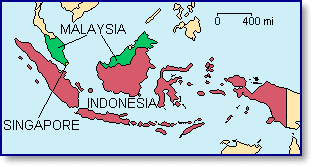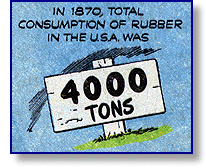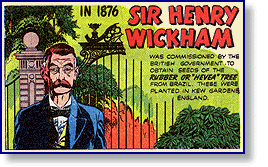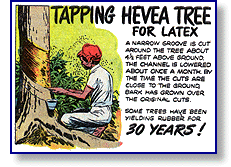 Destination Singapore:
Destination Singapore:
Ridley's Rubber Farms

 Destination Singapore:
Destination Singapore:
Our next stop is in Singapore, and the year is 1888. This year a British botanist named Henry Nicholas Ridley director of the Singapore Botanical Garden, Singapore being a British colony at this time. Ridley is very interested in some plants which have been shipped to Singapore from the Royal Botanical Garden in London.
 Now the biggest problem with rubber is that there just isn't enough of it. Most of the world's
rubber is harvested from a number of plants that grow wild in South America and in Africa.
Wild plants can only produce so much rubber, and even then it isn't of consistent quality.
An early attempt to cultivate rubber trees in plantations in Brazil has recently been halted by
a leaf blight.
Now the biggest problem with rubber is that there just isn't enough of it. Most of the world's
rubber is harvested from a number of plants that grow wild in South America and in Africa.
Wild plants can only produce so much rubber, and even then it isn't of consistent quality.
An early attempt to cultivate rubber trees in plantations in Brazil has recently been halted by
a leaf blight.
 Hancock and his associates had their eyes on the British colonies of southeast Asia. The
kingpins of the British rubber industry figured that if they could start rubber plantations in
the British colonies, not only would they have a better supply of rubber, but the supply would
also be under British control.
Hancock and his associates had their eyes on the British colonies of southeast Asia. The
kingpins of the British rubber industry figured that if they could start rubber plantations in
the British colonies, not only would they have a better supply of rubber, but the supply would
also be under British control.
So the seeds were smuggled back to Britain and were successfully grown into little saplings. Eventually the saplings were then shipped to the colonies. Eleven were addressed to the Singapore Botanical Garden.
The Singapore Botanical Garden's new director, Henry Ridley, sets to work on rubber plants, comparing them with other rubber-producing plants, and figuring out the best way to harvest the rubber. He comes up with a method that is still used to this day. In 1896, the first plantations will begin growing rubber trees in the British colony of Malaya and in the Dutch East Indies (later to become independent as Malaysia and Indonesia, respectively), and Thailand. By 1910 their rubber will be ready for market.

|
|
And with good reason. More than once a nation will have its rubber supply cut off by an enemy. The first time will be during World War I. Britain's Royal Navy will keep Germany from getting any rubber from southeast Asia. By the time of this war, combat will have become highly mechanized, and all the new-fangled death machines will need rubber hoses, gaskets, and tires to work. The Germans will be stuck using a crude synthetic called methyl rubber, not a very good material at all.
Meanwhile, everyone's worst fears would soon be realized, and events in eastern Asia would bring on a rubber crisis.
1879: In New Jersey, Thomas Edison invents the light bulb.
The Great Rubber Adventure - Rubber production continued in South America, even after Sir Henry Wickham smuggled all those rubber seeds out of Brazil. Read all about it on this site from Marine Expeditions, Inc.
Methods of Tapping Rubber Latex - natural rubber is still harvested in a way very similar to the methods used in Ridley's time. Read about how to get rubber from a hevea tree from this site from Immune.com.
The Story of Malaysian Natural Rubber - history of the industry in Malaysia, from the Malaysian Rubber Board.
1. Ebsen, Gary L. A Visitor's Guide to Phoket. Plain Paper Book Guide Co., Ltd., 1997.
3. Burke, James. Connections. Boston: Little, Brown and Co., 1978.
Sir Henry Wickham: From Wonder Book of Rubber, 1947, copyrighted material of The BFGoodrich Company reproduced with the permission of The BFGoodrich Company.
Cartoon of rubber harvesting: From Wonder Book of Rubber, 1947, copyrighted material of The BFGoodrich Company reproduced with the permission of The BFGoodrich Company.